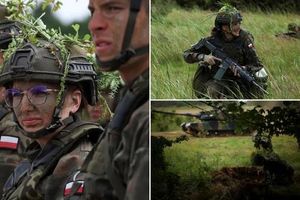Wildfires have taken center stage across the western United States, challenging residents and firefighters alike. With increasing intensity, these fires have sparked fears of devastation previously seen during past catastrophes.
The Park Fire, California's largest active wildfire, has become particularly alarming, overshadowing regions and raising concerns over safety. This fire ignited when someone pushed a burning car down the hill, demonstrating how quickly disasters can spiral out of control.
Firefighters raced against time as the fire expanded rapidly, consuming more than 130 structures and threatening thousands more. With the flames reaching 374 square miles, comparisons have been drawn to the disastrous 2018 Camp Fire, which claimed 85 lives and destroyed countless homes.
At the forefront of the fire-fighting efforts is Cal Fire incident commander Billy See, who remarked, "There’s a tremendous amount of fuel out there, and it’s going to continue with this rapid pace." His statement encapsulates the dire circumstances facing crews on the ground.
The situation is equally dire beyond California’s borders. From Idaho to Washington State, numerous communities have been evacuated due to fast-moving fires sparked by relentless lightning.
Meanwhile, the state of Oregon is grappling with its largest blaze, the Durkee Fire, which has merged with the Cow Fire to affect nearly 630 square miles. Struggling to contain this beast, firefighters have reported just 20% of it being under control.
On the front lines, reports of loss are coming thick and fast. A firefighter tragically lost their life when their plane crashed over eastern Oregon, highlighting the personal risks involved when battling nature's wrath.
The urgency grows each day as the National Interagency Fire Center reported over 110 fires burning across 2,800 square miles. Sources attribute such precarious fire conditions to climate change, which is increasing the frequency of lightning strikes amid record-breaking heat.
Yet, one of the human stories stands out amid the chaos. Carli Parker, who was forced to evacuate her home due to the Park Fire, reflects on the dangers of living so close to wildfires, having experienced similar evacuations before.
Her comments reveal the raw emotion behind such disasters: “I think I felt like I was in danger because the police had come to our house...they were running to their vehicle after telling us...we need to self-evacuate.”
Survival stories like Parker's paint a vivid picture of the mental toll on evacuees. Many families find shelter outside Red Cross facilities, as some will not allow pets inside, leading to heartbreaking decisions.
For some residents like Sherry Alpers, their pets' well-being takes precedence over material loss. Alpers noted, “I’m kind of worried, but notthat much. If it’s gone, it’s gone.”
Such sentiments resonate throughout the affected regions, where people's lives have been uprooted. Similarly, many evacuees, like Brian Bowles, grapple with uncertain futures as they try to prioritize comfort and safety.
Yet, the destruction isn't limited to California; the Canadian Rockies are facing their share of devastation. A wildfire has driven 25,000 people from Jasper National Park, underscoring the expansive reach of this disaster.
This year alone, more than 27,000 wildfires have blazed across the U.S., scorching over 5,800 square miles. Canada has similarly seen over 3,700 fires, burning more than 8,000 square miles, leaving communities hopeless on several fronts.
To combat the fires, multiple aerial and ground resources are deployed across affected regions. Aircraft, personnel, and equipment are constantly tasked with keeping homes and livelihoods intact.
Among those responsible for disaster response is FEMA, which is providing assistance to communities. The agency has already distributed about $5.5 million across the affected areas, but with demands increasing post-floods, many locals feel their needs remain unmet.
Ruidoso Mayor Lynn Crawford expressed urgent concerns about federal aid, emphasizing the pressing need for timely support for local survivors. He noted, “We want to see actual money in people’s hands.”
This sentiment rings true as residents remain skeptical of governmental efforts to alleviate their suffering, stating they often struggle just to get by. Despite FEMA aid being dispensed, the lack of immediate relief is palpable among community members seeking assistance.
Meanwhile, with the North American monsoon season expected to bring incoming rains, concerns over flooding continue to loom. This is particularly important for residents who have already faced the devastation of wildfires.
For many, it’s about survival; as they deal with the reality of evacuations and the uncertainty of returning home, hope becomes scarce. Local officials assure residents of continuous efforts to manage the fires, but the threat remains high.
Firefighters are battling not only the flames but also the underlying conditions exacerbated by climate change. Their uphill battle involves keeping homes intact, saving livelihoods, and, above all, ensuring civilian safety.
The speed and ferocity of these wildfires highlight the urgent need for community preparedness and long-term solutions to climate factors. Everyone affected is still waiting for answers, support, and, hopefully, the possibility of returning to their homes.
With every passing day, the picture might seem bleak, but communities continue to strive for resilience. They know the uphill struggles they face, yet they remain hopeful for recovery, taking it one day at a time.
Each story of loss only reinforces the resolve of firefighters and communities to fight back against nature’s fury. They band together, embodying the spirit of community as they face these relentless wildfires head-on.
The issue extends beyond the immediate wildfires; it prompts discussions about climate policies, forest management, and emergency preparedness. The consequences of neglecting these areas could lead to more intense fire seasons.
For them, the battle against the flames is not just physical—it's personal. The collective experience of these families and firefighters will shape the narrative of wildfire resilience for future generations.



